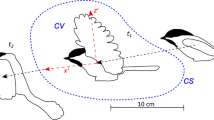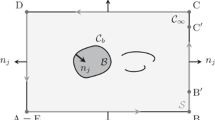Abstract
It is often difficult, if not impossible, to measure the aerodynamic or hydrodynamic forces on a moving body. For this reason, a classical control-volume technique is typically applied to extract the unsteady forces. However, measuring the acceleration term within the volume of interest using particle image velocimetry (PIV) can be limited by optical access, reflections, as well as shadows. Therefore, in this study, an alternative approach, termed the derivative-moment transformation (DMT) method, is introduced and tested on a synthetic data set produced using numerical simulations. The test case involves the unsteady loading of a flat plate in a two-dimensional, laminar periodic gust. The results suggest that the DMT method can accurately predict the acceleration term so long as appropriate spatial and temporal resolutions are maintained. The major deficiency, which is more dominant for the direction of drag, was found to be the determination of pressure and unsteady terms in the wake. The effect of control-volume size was investigated, suggesting that larger domains work best by minimizing the associated error in the determination of the pressure field. When decreasing the control-volume size, wake vortices, which produce high gradients across the control surfaces, are found to substantially increase the level of error. On the other hand, it was shown that for large control volumes, and with realistic spatial resolution, the accuracy of the DMT method would also suffer. Therefore, a delicate compromise is required when selecting control-volume size in future experiments.











Similar content being viewed by others
References
David L, Jardin T, Farcy A (2009) On the non-intrusive evaluation of fluid forces with the momentum equation approach. Measurement Science and Technology 20 No. 9, 095401 (11pp)
Jardin T, Chatellier L, Farcy A, David L (2009) Correlation between vortex structures and unsteady loads for flapping motion in hover. Exp Fluids 47:655–664
Kat R, Oudheusden BW, Scarano F (2008) Instantaneous planar pressure field determination around a square-section cylinder based on time-resolved stereo-PIV. In: 14th international symposium on applications of laser techniques to fluid mechanics in Lisbon
Kurtulus DF, Scarano F, David L (2006) Unsteady aerodynamics force estimation on a square cylinder by TR-PIV. Exp Fluids 42:185–196
Noca F, Shiels D, Jeon D (1997) Measuring instantaneous fluid dynamic forces on bodies, using only velocity fields and their derivatives. J Fluids Struct 11:345–350
Noca F, Shiels D, Jeon D (1999) A comparison of methods for evaluating time-dependent fluid dynamic forces on bodies, using only velocity fields and their derivatives. J Fluids Struct 13:551–578
Rival D, Manejev R, Tropea C (2010) Measurement of parallel blade-vortex interaction at low Reynolds numbers. Exp Fluids 49:89–99
Rival D, Prangemeier T, Tropea C (2009) The influence of airfoil kinematics on the formation of leading-edge vortices in bio-inspired flight. Exp Fluids 46(5):823–833
Rival D, Schönweitz D, Tropea C (2011) Vortex interaction of tandem pitching and plunging plates: a two-dimensional model of hovering dragonfly-like flight. Bioinspiration Biomimetics 6(1):016008
Unal M, Lin J-C, Rockwell D (1997) Force prediction by PIV imaging: a momentum-based approach. J Fluids Struct 11:965–971
van Oudheusden BW, Scarano F, Roosenboom EWM, Casimiri EWF, Souverein LJ (2007) Evaluation of integral forces and pressure fields from planar velocimetry data for incompressible and compressible flows. Exp Fluids 43(2–3):153–162
Wu J-Z, Pan Z-L, Lu X-Y (2005) Unsteady fluid-dynamic force solely in terms of control-surface integral. Phys Fluids 17:098102-1
Acknowledgments
The authors would like to acknowledge the useful suggestions provided by the referees.
Author information
Authors and Affiliations
Corresponding author
Rights and permissions
About this article
Cite this article
Mohebbian, A., Rival, D.E. Assessment of the derivative-moment transformation method for unsteady-load estimation. Exp Fluids 53, 319–330 (2012). https://doi.org/10.1007/s00348-012-1290-8
Received:
Revised:
Accepted:
Published:
Issue Date:
DOI: https://doi.org/10.1007/s00348-012-1290-8




